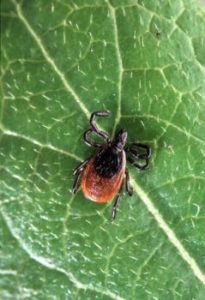Blog
Tagged In: Climate Change, Fossil Fuels, Green Living
Ticked about ticks.
Melanie Houston, Managing Director of Water Policy & Chief of Organizational Planning, July 13, 2017
 Yesterday, I was getting my 3 year-old daughter Quinn dressed for school when I noticed a small, dark pin-head shape on her upper thigh. Having grown up in the country, I knew right away what this was: a deer tick!
Yesterday, I was getting my 3 year-old daughter Quinn dressed for school when I noticed a small, dark pin-head shape on her upper thigh. Having grown up in the country, I knew right away what this was: a deer tick!
I immediately went into mama-bear mode. How dare this vile creature latch its jaws onto my baby! As I removed the tick from her little body, questions filled my mind. Should I take her to the hospital or doctor’s office right away? How did I not notice this last night when I put her pajamas on? Did she pick it up just playing in our back yard and how long has it been on her? Would my daughter suffer from lyme disease and was her life at risk? This was the first tick bite on my first and only daughter. I was ticked, but I was also scared.
After a deep breath, I called my close friend who is a pediatrician to ask what my next steps should be. The advice was this: watch her closely for a rash on her legs and flu-like symptoms and get treatment right away if any of those symptoms appear. If the tick was not engorged (which thankfully it was not) it had most likely not been attached for more than 24 hours and the risk of her contracting lyme disease was much lower.
Ticks carry over a dozen diseases we are vulnerable to, with the most well-known being the bacterial infection Lyme disease. The severity of Lyme disease can vary greatly depending on the health of the person infected and the length of the infection. The number of Lyme disease cases in the United States has nearly doubled since 1991, correlated to an increase in tick numbers and an expanded range. Both factors of which are driven by our changing climate.
To some climate change can feel like a distant issue that only affects far off places, a problem for the future. Well, I share my family’s personal story with you, today, to provide evidence that climate change is already affecting Ohioans like you and me. Simply put, climate change is crawling right into our summer plans. According to the National Pest Management Association, pests like mosquitoes and ticks are expected to have both longer active seasons and increased numbers.
Buggier days and nights are going to change how Ohioans enjoy our summers. With more mosquitos in the air, we’ll spend less evenings on the baseball diamond and less nights out by the bonfire. With more ants and termites searching for food, our homes are more susceptible to invasions, and we’ll have to use more chemicals to avoid them. With more disease-ridden ticks lurking on our favorite trails and even in our backyards, we might go for fewer hikes or let our kids play outside less often for fear of being exposed to dangerous tick-borne illnesses.
Climate change, driven by the release of greenhouse gases like carbon dioxide (CO2) and methane, is also affecting our weather, now. January and February were both warmer and wetter than average for Ohio with a number of record-breaking warm days. Ticks, like many insect pests, don’t migrate in the winter; they find places to hide until winter is over. When winters are warmer, with less temperatures below-freezing, the number of adults and larvae that survive the winter increases. This means there are more ticks around in spring to do what they do best: bite us and reproduce. Warmer weather also increases tick numbers because it increases the abundance of one of their main food sources: mice.
Right now, I am waiting and watching for any signs of infection. Quinn seems to be doing fine, but I am still a little shaken. Going forward, I will be more vigilant in checking my daughter for ticks and in better preparing her to go outside. But I also want to share the lessons that I learned: Always check yourself, your kids and your pets closely during the summer! Especially if you’ve spent time in a wooded or prairie area.
Take precautions when outdoors. Wear bug repellant, long sleeves and pants (if you can bear it), and light colored clothing so the dark ticks are easy to spot. If you do find a already latched on your body, remove it properly and promptly with tweezers and watch for the symptoms of Lyme disease. And lastly, continue fighting for climate action at the local, state, and national levels! Unfortunately, this increase in pest activity could become Ohio’s new normal if our leaders fail to act.